|
TRANSLATE THIS ARTICLE
Integral World: Exploring Theories of Everything
An independent forum for a critical discussion of the integral philosophy of Ken Wilber
 Jan Krikke is a former Japan correspondent for various media and former managing editor of Asia 2000 in Hong Kong. He pioneered the study of axonometry, the Chinese equivalent of European linear perspective overlooked by Jean Gebser. He is the author of several books, including Leibniz, Einstein, and China, and the editor of The Spiritual Imperative, a macrohistory based on the Indian Varna system by feminist futurist Larry Taub. Jan Krikke is a former Japan correspondent for various media and former managing editor of Asia 2000 in Hong Kong. He pioneered the study of axonometry, the Chinese equivalent of European linear perspective overlooked by Jean Gebser. He is the author of several books, including Leibniz, Einstein, and China, and the editor of The Spiritual Imperative, a macrohistory based on the Indian Varna system by feminist futurist Larry Taub.
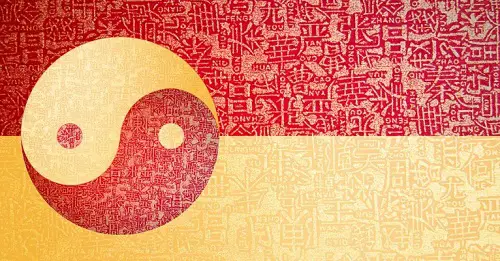 The yin and yang of metamodernismJan Krikke
Metamodernists see the culture wars raging in the Western world as a battle between modernist and postmodernist values
Metamodernism, an intellectual movement that emerged in Europe about 10 years ago, has an ambitious goal: formulating a response to a world “that feels like it's unraveling through climate change, culture war, bio-precarity, political corruption, and myriad economic failures.” The metamodernist community, many of them intellectuals in their 40s, share a concern about the ideological, social, and cultural malaise in European society. They argue we are “between two worlds”—the now-dying system and a system that has yet to be born. As a way out, the metamodernists want to reconcile their two antagonistic predecessors. They see the culture wars currently raging in the Western world as a battle between modernist and postmodernist values. Their response: “You are both right. We're going to synthesize opposites and build something new from there.” 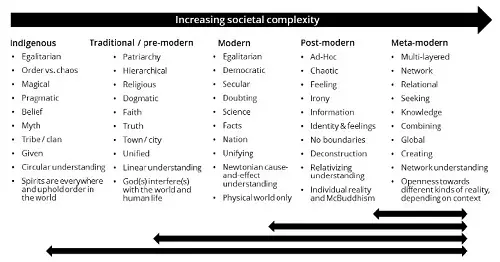
© Lene Rachel Anderson & Nordic Bildung, 2019
Metamodernism has roots in integral theory, a stage-development theory developed by Ken Wilber. Integral is a synthesis of Western developmental psychology and Eastern religious traditions, mostly Vedanta and Zen. Collaboration between Wilber and Spiral Dynamics, a model of evolutionary development, led to Spiral Dynamics Integral, or SDi. Development stage theory can give insight into the history of human development, and it can identify major changes in the human psyche. When Galileo defied the Christian dogma that the Earth is at the center of the universe, Europe moved from an age of faith to an age of reason. The Enlightenment period transformed Europe from Traditional to Modern. 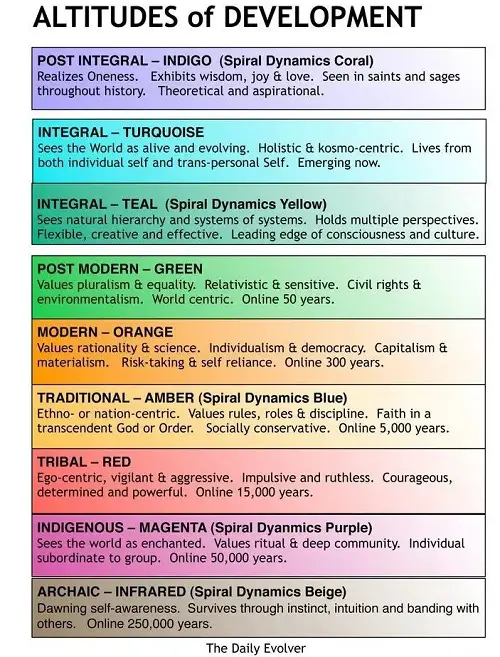
Development stages in Spiral Dynamics Integral (SDi).
Applying stage theory to the contemporary world is not without pitfalls. For one, it assigns people, groups, and countries to hierarchical levels. Moreover, it assumes all people and all countries will go through the same developmental stage in the same sequence. Integralists typically argue that Northern Europe and the Anglo-Saxon world have the largest percentage of Integral-Teal (see the color chart above) people and thus the highest level of development. Based on social and gender equality, the ranking makes sense. However, we can't assume the rest of the world will follow the Western sequence from Modern to Postmodern to Integral, if only because non-Western countries can't be easily pigeon-holed in the Integral stage model.
Based on Integral precepts, China is a mix of Traditional and Modern. But seen from a technological perspective, China is playing a key role in shaping post-industrial society. It has different “historical baggage” and may skip the Postmodern stage. The same could be true of India, Africa, and the rest of the Global South. 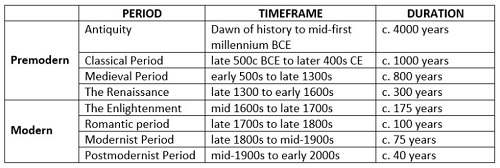
The division of the premodern and modern eras in Europe. Source: Brendan Graham Dempsey (A Severan), Metamodernism and the Return of Transcendence
MetaMetamodernism, put on the map in 2010 by two Dutch cultural theorists, Timotheus Vermeulen and Robin van den Akker, doesn't quite overcome the still-prevailing Eurocentric worldview, but it points in the right direction; it shifts the focus from integral's preoccupation with personal development to concerns about society as a whole and in a larger, global context. 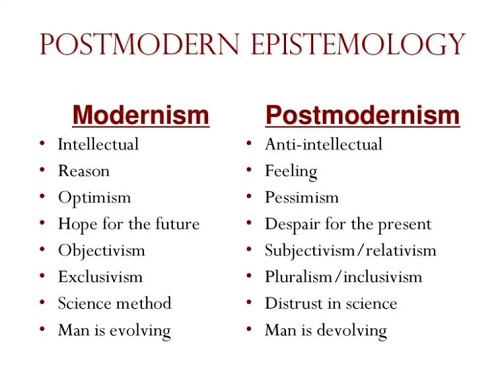
Attitudes of the modern and postmodern eras.
Leading theorist Daniel P Görtz explained the need for a shift in focus during a TED talk, saying: “If we hold on to our Modernist and Postmodernist mindset, we will not have the values that are going to match the complexity of the global, post-industrial, digital age.” The prefix meta has Greek origins. Plato spoke of metaxis to describe an oscillation and simultaneity between and beyond opposed poles. In metamodernism, oscillation “is not balance but a pendulum swinging between 2, 3, 5, 10, innumerable poles. Each time the metamodern enthusiasm swings toward fanaticism, gravity pulls it back toward irony; the moment its irony sways toward apathy, gravity pulls it back toward enthusiasm.” The oscillation between polarities of the metamoderist is comparable to the Chinese notion of yin and yang. The gravity that maintains the force in the pendulum's swing is what the Chinese refer to as ch'i or qi. It is the manifestation of the dynamic tension between yin and yang. It is the same tension that created the Confucian “Middle Way”—the path between extremes that causes the least friction.
The Metamodernist Manifesto echoes this focus on reconciling dynamic opposites. It wants metamodernism to be defined as “the mercurial condition between and beyond irony and sincerity, naivety and knowingness, relativism and truth, optimism and doubt.…” As their manifesto explains:
If the latter conjures up a cybernetic image of a metamodern metaverse, the Metamodern Manifesto predates the metaverse by more than a decade. But the “colossal electric machine” is a useful metaphor to describe cybernetic, postindustrial society. Credit for the first use of the prefix meta in the modern context goes to Indian yoga guru Shri Nirmale Devi. In 1997, she published the book Meta Modern Era. Metamodernist scholar Jonathan Rowson, co-author of the seminal book Metamodernism: Dispatches from a Time Between Worlds, takes the Integral-Metamodernist back to its original source of inspiration. He writes: “Meta Modern Era by Shri Nirmala Devi gave a quasi-Vedantic spiritual conception of the [metamodernist] idea in 1997, and much of the paradoxical and playful nature of Taoism sometimes feels metamodern in spirit, even if the Chinese Communist Party does not.” The latter is a fair point to make from an integral-metamodern perspective. But the Chinese government knows its long history, and its future. At official government gatherings, the communist icon of hammer and sickle has given way to the Taoist “mountain-water picture.” The imposing image symbolizes the birth of yin and yang, the Chinese conception of Creation. The ancient sages said: “When the yin and yang, initially united, separated forever, the mountains poured forth water.”
The metamodernists are standing on the shoulders of integral theory, but they shift the focus from “I” to “We.” That could be their enduring contribution. The development of post-industrial society, the “colossal electric machine,” requires teamwork, a common purpose, and thus more “We” than “I”. On all accounts, China arguably has a head start.
|